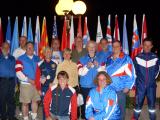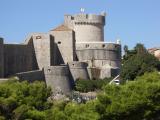
Our first stop in Croatia was the capital city of Zagreb. Zagreb is the most populous city in Croatia, with about 800,000 residents in the core city and 1.3 million in the greater metropolitan area, making it slightly smaller than Austin, Texas. Although the city can trace its history to a Roman settlement in 1 AD, it is one of the more modern cities in Croatia, and was officially chartered with the name Zagreb only in 1851. The city is full of sidewalk cafes and 19th century architecture.

The Gorski kotar is the mountainous region of northwestern Croatia, and is known for its forests. It is part of the Dinaric Alps, a range of mountains that extends from Slovenia in the north to Albania in the south. We drove through the mountains on our trip from Zagreb to Opatija, spent several days in the mountains as part of the 2010 World ARDF Championships, and then drove through them again on our way from Opatija to Split.

We spent the better part of a week in Opatija, a resort town on the Adriatic coast in northwest Croatia. Opatija has more than century-long tradition as a destination resort town. It was first developed in the nineteenth century, when Croatia was part of the Hapsburg Empire, as an Austrian counterpart to the French Riviera. We stayed in the Hotel Kvarner, the oldest hotel in the town.

Jen and I attended the 15th World Amateur Radio Direction Finding Championships, September 13-18, 2010, in Opatija, Croatia. It was the first world championships to be held in Croatia, and the first to be held in the former Yugoslavia since the wars of 1991-1995. It was also the first ARDF World Championships with a separate competition for blind competitors. This was our second world championships.

Jen and I spent an afternoon visiting Lovran (population 3,200), a small coastal town on the eastern shore of the Istrian peninsula. Lovran is at the southern terminus of the lungomare, a seaside walking path that covers 12 km (7.5 miles) of coastline all the way from Rijeka in the north. Lovran's special attraction is its very dense city center, with pedestrian-only streets that haven't changed since medieval times. Although it was only 150 meters east-west and 100 meters north-south, the old town had the feeling of stepping back in time to an older age, with very few tourists.

Split (population 225,000) is the second-largest city in Croatia, and the largest city on the Dalmatian coast. In 305 A.D., when the Roman Emperor Diocletian decided to retire from politics, he chose to leave Rome for his native Dalmatia. He built an enormous palace on the Apennine Peninsula with a harbor that would become the core of the Roman city of Spalatum. In 639 A.D., the Slavs sacked the much larger nearby Roman city of Salona. The remaining Roman population moved to Spalatum (Split in Croatian), which because of the palace walls was more easily defensible.

From Split, we took the bus to the city of Dubrovnik. Our route followed the A1 tollway all the way to its southern terminus, where we continued along the old coastal highway. As Dubrovnik is located in an exclave of Croatia, we had to drive about 13 kilometers (8 miles) through Bosnia and Herzegovina. During the drive, we saw parts of Croatia's wine country.

Dubrovnik is an ancient walled city that is listed as a UNESCO World Heritage Site. Then known as Ragusa, the city became one of the most important maritime city-states during the middle ages and early Renaissance. Through diplomacy and trade, Ragusa remained independent of the surrounding empires of Venice, the Hapsburgs, and the Ottoman Turks. Following the Napoleonic Wars, the city was administered by Austria-Hungary and integrated into what would become modern Croatia.

Lokrum Island is an island close to the old walled city of Dubrovnik, and is a popular day trip. The island once belonged entirely to the Benedictine order, and a large monastery was built on the island in 1023. The mostly 14th century monastery buildings were badly damaged in the earthquake of 1667, and the Benedictines left the island entirely in 1798. Today Lokrum is a Nature Reserve and a Special Forest Vegetation Reserve. It is a popular swimming destination.

Looming over the city of Dubrovnik to the north-northeast, Mount Srd is 412 meters (1350 feet) high. Commanding a strategic position over the old city, occupying French forces in 1808 built Fort Imperial atop Mount Srd to protect the city from the Austrian army. A handful of Croatian defenders held Mount Srd against repeated Serbian attacks in the 1991-1992 Siege of Dubrovnik. Today, Fort Imperial is a war museum.